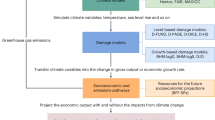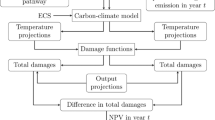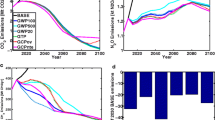Abstract
Efficient policies to control trace gas emissions require estimation of an appropriate “exchange rate” among these gases; i.e. the relative value of reducing emissions of each gas. A dynamic stock pollutant model is developed that considers damages associated with both non-climatic and climatic effects of the gases, differing atmospheric lifetimes of the gases, the discount rate, and non-linear damages. The index value and shadow value of control are estimated for carbon dioxide, carbon monoxide, methane, nitrous oxide and the 4 major chlorofluorocarbons (CFCs). The value of control for short-lived relative to long-lives gases is lower for low discount rates and quadratic compared with linear damages. The relative value of control for all gases falls relative to carbon dioxide if one considers the direct beneficial effects of carbon dioxide on agriculture. The general approach developed in the paper may have application for other environmental problems where multiple substances pose individual risks but also jointly contribute to a single risk.
Similar content being viewed by others
References
Adams, R. A., B. A., McCarl, D. J., Dudek, and J. D., Glyer (1988), ‘Implication of Global Climate Change for Western Agriculture’, Western Journal of Agricultural Economics 13, 348–356.
Arthur, L. M. and F., Abizadeh (1988), ‘Potential Effects of Climate Change on Agriculture in the Prairie Region of Canada’, Western Journal of Agricultural Economics 13, 216–224.
Ayres, R. U. and J., Walter (1991), ‘The Greenhouse Effect: Damages, Costs and Abatement’, Environment and Resource Economics 1, 237–270.
Baily, M. (1982), ‘Risks, Costs and Benefits of Fluorocarbon Regulation’, American Economic Review Papers and Proceedings 72, 247–250.
Caldeira, K. and M. R., Rampino (1992), ‘Mount Etna CO2 May Affect Climate’, Nature 355, 401–402.
Cline, William R. (1992), Global Warming: The Economic Stakes, Institute for International Economics, Washington, D.C. (May).
D'Arge, R., W. D., Schulze, and D., Brookshire (1982), ‘Carbon Dioxide and Intergenerational Choice’, American Economic Review, Papers and Proceedings 72, 251–256.
Eckaus, R. (1992), ‘Comparing the Effects of Greenhouse Gas Emissions on Global Warming’, The Energy Journal 13, 25–34.
Edmonds and Barnes (1990), ‘Estimating the Marginal Cost of Reducing Global Fossil Fuel CO2 Emissions’, PNL-SA-18361, Pacific Northwest Laboratory, Washington, D.C. (August 1).
Epstein, J. and R., Gupta (1991), ‘Controlling the Greenhouse Effect: Five Global Regimes Compared’, Brookings Occasional Papers, Brookings Institution, Washington, D.C.
Freeman, M. (1989), ‘Using Economic Incentives to Control CO2 Emissions’, Mimeo, Resources for the Future, Inc., Washington D.C.
Hahn, R. (1988), ‘Economic Prescription for Environmental Problems: How the Patient Followed the Doctor's Orders’, Journal of Economic Perspectives 2.
Hammond, A. L., E., Rodenburg, and W., Moomaw (1990), ‘Accountability in the Greenhouse’, Nature 347, 705–706.
Heck, W. (1989), ‘Assessment of Crop Losses from Air Pollution in the United States’, in J. MacKenzie and M. El-Ashry (eds.), Air Pollution's Toll on Forests and Crops, pp. 235–315, Yale University Press, New Haven.
Houghton, J. T., G. J., Jenkins, and J. J., Ephraums, ed. (1990), Climate Change: The IPCC Scientific Assessment, 365 pp. Cambridge University Press, Cambridge, MA.
Hyashi, F. (1982), ‘Tobin's Marginal q and Average q: A Neoclassical Interpretation’, Econometrica 50, 213–224.
Jones, R. L. and F. B., Mitchell (1991), ‘Is Water Vapor Understood?’, Nature 353, 210.
Kamein, M. I. and N. L., Schwartz (1981), Dynamic Optimization: The Calculus of Variations and Optimal Control in Economics and Management, North-Holland, Amsterdam.
Kane, S., J., Reilly, and J., Tobey (1992), ‘An Empirical Study of the Economic Effects of Climate Change on World Agriculture’, Climatic Change 21, 17–35.
Keeler, E., M., Spence, and R., Zeckhauser (1971), ‘The Optimal Control of Pollution’, Journal of Economic Theory 4, 19–34.
Kimball, B. A. (1983), ‘Carbon Dioxide and Agricultural Yield: An Assemblage and Analysis of 770 Prior Observations’, WCL Report 14. U.S. Water Conservation Laboratory, Phoenix, AZ.
Lashof, D. A. and D. R., Ahuja (1990), ‘Relative Global Warming Potentials of Greenhouse Gas Emissions’, Nature 344, 529–531.
Manne, A. S. and R. G., Richels (1990), ‘CO2 Emissions Limits: An Economic Cost Analysis for the U.S.A.’, Energy Journal 11, 51–75.
Mohnen, V. A., W., Goldstein, and W. C., Wang (1990), ‘The Scientific Challenge of Measuring climate Change’, Energy Policy 18, 641–651.
Morgenstern, R. D. (1991), ‘Towards a Comprehensive Approach to Global Climate Change Mitigation’, American Economic Review 81, 140–145.
National Climate Program Office (NCPO) (1989), ‘Climate Impact Response Functions’, Report of a Workshop held at Coolfont, West Virginia (September 11–14).
Nordhaus, W. D. (1991a), ‘To Slow or Not to Slow: The Economics of the Greenhouse Effect’, The Economic Journal 101, 920–937.
Nordhaus, W. D. (1991b), ‘The Cost of Slowing Climate Change: A Survey’, Energy Journal 12, 37–65.
Nordhaus, W. D. (1990), ‘A Sketch of the Economics of Global Climate Change’, Paper presented at the Allied Social Science Association Meetings (Dec.), Washington, D.C.
Nordhaus, W. D. (1989), ‘A Survey of Estimates of the Costs of Reduction of Greenhouse Gases’, Department of Economics, Yale University, New Haven.
Parry, M. L. and T. R., Carter (1989), ‘An Assessment of the Effects of Climate Change on Agriculture’, Climatic Change 15, 95–116.
Peck, S. C. and T. J., Teisberg (1992), ‘CETA: A Model for Carbon Emissions Trajectory Assessment’, The Energy Journal 13, 55–77.
Ramanathan, V., R. D., Cess, E. F., Harrison, P., Minnis, B. R., Barkstrom, E., Ahmed, and D., Houtmann (1989), ‘Cloud Radiative Forcing and Climate: Results from the Earth Radiation Budget Experiment’, Science 243, 57–63.
Ramaswamy, V., M. D., Schwarzkopf, and K. P., Shine (1992), ‘Radiation Forcing of Climate from Halocarbon-Induced Global Stratospheric Ozone Loss’, Nature 355, 810–812.
Reilly, J. (1991), ‘Carbon Dioxide Emissions and Global Environmental Change’, in G. I., Pearman (ed.), Limiting the Greenhouse Effect: Options for Controlling Atmsopheric CO 2 Accumulation, John Wiley & Sons Ltd., London (forthcoming).
Reilly, J. M., J. A. Edmonds, R. H. Gardner, and A. L. Brenkert (1987), ‘Uncertainty Analysis of the IEA/ORAU CO2 Emission Model’, The Energy Journal 8(3).
Schelling, T. (1983), ‘Prices as Regulatory Instruments’, in T. Schelling (ed.), Incentives for Environmental Protection, MIT Press, Cambridge Mass.
Stewart, R. B. and J. B. Wiener (1990), ‘A Comprehensive Approach to Climate Change: Using the Market to Protect the Environment’, The American Enterprise (Nov./Dec.), 75–80.
Tietenberg, T. (1992), ‘Implementation Issues: A General Survey’, in U.N. Trade and Development Conference, Combatting Global Warming, pp. 127–149, United Nations, New York.
U.S. EPA (1983), Can We Delay A Greenhouse Warming? Office of Strategic Studies, Washington, D.C. (September).
Victor, David J. (1990), ‘Sensitivity of Global Warming Potentials to Feedback and Carbon Cycle Assumptions: Implications for Policy’, draft, Massachusetts Institute of Technology, Cambridge, MA.
Watson, A. (1992), ‘Conveying That Sinking Feeling’, Nature 356, 561–562.
Weitzman, M. (1974), ‘Prices vs. Quantities’, Review of Economic Studies 41, 477–492.
Wuebbles, D. J. and J. A., Edmonds (1988), ‘A Primer on Greenhouse Gases’, DOE/NBB-083, United States Department of Energy, Washington, D.C. (March).
Wuebbles, D. J. and J. A. Edmonds, A Primer on Greenhouse Gases, Lewis Publishers, Chelsea, Michigan (forthcoming).
Author information
Authors and Affiliations
Additional information
The views expressed in this document are solely those of the authors and do not reflect the views of the U.S. Department of Agriculture or the United States government.
We would like to acknowledge the helpful comments and suggestions of Bruce Larson, Dick Brazee, and Jae Edmonds while taking full responsibility for any remaining errors.
Rights and permissions
About this article
Cite this article
Reilly, J.M., Richards, K.R. Climate change damage and the trace gas index issue. Environmental and Resource Economics 3, 41–61 (1993). https://doi.org/10.1007/BF00338319
Issue Date:
DOI: https://doi.org/10.1007/BF00338319




